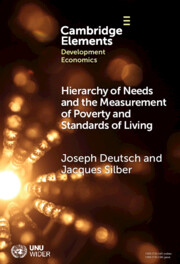546 results
Chapter 4 - Patterns of Industry
-
-
- Book:
- Nineteenth-Century Literature in Transition: The 1830s
- Published online:
- 30 May 2024
- Print publication:
- 06 June 2024, pp 84-104
-
- Chapter
- Export citation
Association of parental level of education and child factors on length-for-age indicator among socially vulnerable children aged 6-24 months from a Brazilian state using Structural Equation Modelling
-
- Journal:
- British Journal of Nutrition / Accepted manuscript
- Published online by Cambridge University Press:
- 28 May 2024, pp. 1-23
-
- Article
-
- You have access
- Export citation
Chapter 3.2 - Causes of Depression
-
-
- Book:
- Seminars in General Adult Psychiatry
- Published online:
- 04 April 2024
- Print publication:
- 18 April 2024, pp 89-107
-
- Chapter
- Export citation
1 - Toxic Stress – You Won’t See It Coming (Neither Will Your Doctor)
- from Part I - The Problem
-
- Book:
- Toxic Stress
- Published online:
- 18 April 2024
- Print publication:
- 18 April 2024, pp 19-37
-
- Chapter
- Export citation
Intergenerational Justice and Freedom from Deprivation
-
- Article
-
- You have access
- Open access
- HTML
- Export citation
3 - Traumatic Experience Is Patterned
-
- Book:
- The Social Psychology of Trauma
- Published online:
- 04 April 2024
- Print publication:
- 11 April 2024, pp 44-64
-
- Chapter
-
- You have access
- Open access
- HTML
- Export citation
Using latent class analysis to investigate enduring effects of intersectional social disadvantage on long-term vocational and financial outcomes in the 20-year prospective Chicago Longitudinal Study
-
- Journal:
- Psychological Medicine , First View
- Published online by Cambridge University Press:
- 25 March 2024, pp. 1-13
-
- Article
-
- You have access
- Open access
- HTML
- Export citation
6 - Compassionate Experience
-
- Book:
- Ways of Living Religion
- Published online:
- 07 March 2024
- Print publication:
- 14 March 2024, pp 225-268
-
- Chapter
- Export citation
What it means to be poor: dimensions of economic hardship among older people living in poverty across Europe
-
- Journal:
- Ageing & Society , First View
- Published online by Cambridge University Press:
- 28 February 2024, pp. 1-22
-
- Article
- Export citation

Hierarchy of Needs and the Measurement of Poverty and Standards of Living
-
- Published online:
- 08 February 2024
- Print publication:
- 22 February 2024
-
- Element
-
- You have access
- Open access
- HTML
- Export citation
5 - SDG1, eliminating poverty: improvements to health coverage design as a means to create co-benefits between health system and poverty Sustainable Development Goals
-
-
- Book:
- Health <i>for</i> All Policies
- Published online:
- 11 January 2024
- Print publication:
- 01 February 2024, pp 64-87
-
- Chapter
-
- You have access
- Open access
- HTML
- Export citation
Housing affordability and poverty in Europe: on the deteriorating position of market renters
-
- Journal:
- Journal of Social Policy , First View
- Published online by Cambridge University Press:
- 25 January 2024, pp. 1-24
-
- Article
-
- You have access
- Open access
- HTML
- Export citation
12 - Deprivation, Income Shocks, and Remittances
- from Part III - A Focalised View of Sustainable Development
-
- Book:
- Complexity Economics and Sustainable Development
- Published online:
- 04 January 2024
- Print publication:
- 25 January 2024, pp 323-349
-
- Chapter
- Export citation
Chapter 5 - Piers Plowman and the Inappropriable
-
- Book:
- The Theology of Debt in Late Medieval English Literature
- Published online:
- 04 January 2024
- Print publication:
- 18 January 2024, pp 136-171
-
- Chapter
- Export citation
Chapter 16 - Forgotten Class
- from Part III - Applications: Politics
-
-
- Book:
- Literature and Medicine
- Published online:
- 17 January 2024
- Print publication:
- 18 January 2024, pp 281-296
-
- Chapter
- Export citation
6 - Obstacles to the Provision of Healthcare Services
- from Part II - Thematic Papers
-
-
- Book:
- Mozambique at a Fork in the Road
- Published online:
- 14 December 2023
- Print publication:
- 21 December 2023, pp 136-161
-
- Chapter
-
- You have access
- Open access
- HTML
- Export citation
7 - Growth with Equity?
-
- Book:
- The Tortuous Path of South Korean Economic Development
- Published online:
- 07 December 2023
- Print publication:
- 21 December 2023, pp 198-238
-
- Chapter
- Export citation
Citizenship and mobility of the poor: Sweden during the 19th century
-
- Journal:
- European Journal of Sociology / Archives Européennes de Sociologie , First View
- Published online by Cambridge University Press:
- 15 December 2023, pp. 1-29
-
- Article
-
- You have access
- Open access
- HTML
- Export citation
16 - International Development and Public Health
- from Part 2 - Contexts for Public Health Practice
-
-
- Book:
- Essential Public Health
- Published online:
- 01 December 2023
- Print publication:
- 14 December 2023, pp 303-322
-
- Chapter
- Export citation
Strengthening self-regulation and reducing poverty to prevent adolescent depression and anxiety: Rationale, approach and methods of the ALIVE interdisciplinary research collaboration in Colombia, Nepal and South Africa
- Part of
-
- Journal:
- Epidemiology and Psychiatric Sciences / Volume 32 / 2023
- Published online by Cambridge University Press:
- 13 December 2023, e69
-
- Article
-
- You have access
- Open access
- HTML
- Export citation



